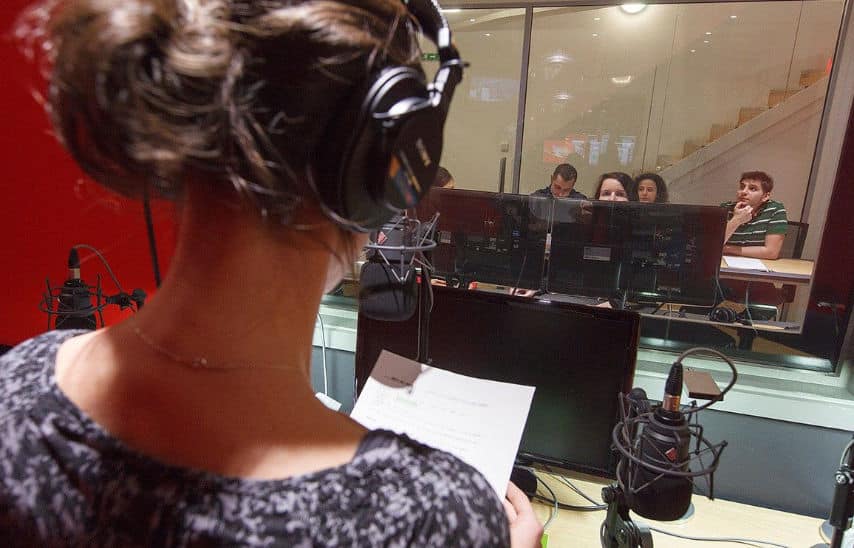In the voice over world, understanding how money works is really important, both for the people lending their voices and for those hiring them. We’re an agency with lots of experience in this field, and we’ve got a good handle on things like voice over buyouts, usage fees and agreements – the kind of stuff that can seem confusing at first.
Our aim is to share our knowledge in a simple and honest way. We believe in making sure everyone – whether you’re a voice artist or someone looking for the perfect voice for your project – gets a fair shake. We’ll walk you through everything you need to know about these fees, breaking it down so it’s easy to understand.
By the end of this, you’ll have a clearer picture of how these fees are set up and what they mean for your projects. Whether you’re just starting out in the industry or you’ve been around the block a few times, we want to help make the voice over world a fair and straightforward place for everyone.
Table of Contents
ToggleThe Basics of Voice Over Fees
Step into the world of voice over projects, and you’ll quickly encounter the concept of the Voice Over Fee. This isn’t just a number plucked from thin air; it’s a carefully considered figure that compensates voice talents for their contribution to your project. Let’s journey through the nuances of this fee to understand its importance in the industry.
What Exactly is a Voice Over Fee?
Picture a scene: a voice artist, filled with a blend of passion and professionalism, enters the studio. Their voice is their instrument, poised to transform your script from mere words on a page into an audible masterpiece. The Voice Over Fee is the price tag for this transformation, a tribute to the artistry and skill poured into every word spoken.
The Living, Breathing Nature of the Voice Over Fee
This fee is not a rigid number but a living entity that adapts to the unique needs of each project. Consider the quaint charm of a local radio ad, requiring just a snippet of voice work. This would naturally invite a modest fee. Now, contrast this with a grand narrative woven for an international documentary – a project demanding extensive time, emotion, and skill. The fee here echoes the grandeur and complexity of the task.
Factors Influencing Voice Over Fees
In the realm of voice over, various elements waltz together to form the final fee. Each factor plays its part in this intricate dance:
- The Artist’s Experience and Skill: Envision a voice artist who can deftly navigate through a spectrum of emotions, capturing the essence of your message with every inflection. These seasoned artists, with their refined skills and impressive portfolios, are akin to lead dancers in this performance, often commanding higher fees for their star quality.
- The Tale of Project Length and Complexity: Every voice over project tells a story, some short and sweet, others long and layered. The longer and more complex the narrative, the more nuanced the performance required, leading to a higher fee. This is the price of crafting a tale that resonates deeply with its audience.
- The Scope of Usage: The journey of a voice over can span from the cosy corners of a local shop to the vast expanse of a global campaign. The wider and longer the voice travels, the greater the fee. It’s a reflection of the voice’s reach and its enduring impact.
- When Time is of the Essence: In the fast-paced world where deadlines are king, swift delivery can be golden. Urgent projects, demanding a quick turnaround, often bear a premium, compensating for the rapid reshuffling of schedules and priorities.
- Market Trends: The voice over market, much like any other, ebbs and flows with demand. High demand periods may see a surge in fees, particularly for sought-after talents, mirroring the market’s pulse.
Understanding these factors is akin to having a backstage pass to the world of voice over financials. It empowers you to navigate the costs with insight and appreciation, ensuring you strike the right chord between budget and quality. In this world, choosing the perfect voice means harmonising the cost with the vision of your project, ensuring that the voice you select not only fits your narrative but also sings in harmony with your financial plans.
What is a Voice Over Buyout?
Let’s step into a scene that’s quite familiar in the voice over world. A voice artist enters a studio, their voice ready to bring a script to life. They’re about to create something that might be heard on TV, radio, online – everywhere. Now, here’s where the idea of a voice over buyout comes into play.
The Story Behind a Voice Over Buyout
Imagine this voice artist has just delivered a stunning performance. Instead of getting paid each time their recording is used, they agree to a one-time deal. This deal, known as a voice over buyout, is a bit like the voice artist handing over a key to the client. This key unlocks unlimited use of that recording. The client can now use this voice over anywhere, as much as they want, and the voice artist won’t ask for more money later. It’s a complete handover of rights, sometimes for a certain time, sometimes forever.
The Benefits of a Buyout for Clients
For clients, a buyout is like being given a free pass. They get this recording that they can play over and over, in any market, on any platform, without ever having to dip into their pockets again. It’s a huge plus, especially for projects with a wide reach or a long shelf life. They don’t have to keep track of how often or where the recording is used. It simplifies everything.
Simplifying Transactions with Buyouts
Think of a buyout as a straightforward deal. It cuts through the usual back-and-forth over payments every time the recording is used. Instead, there’s just one payment, one agreement, and that’s it. It’s clean and simple – the voice talent gets a lump sum, and the client gets complete freedom to use the recording. This simplicity is what makes buyouts an attractive option in the bustling world of voice overs.
How Do We Figure Out a Fair Buyout Fee?
Deciding on a fair price for a buyout isn’t always straightforward. A few things usually help decide what this fee should be:
- Where and How Much It Will Be Used: The extent of the recording’s usage plays a significant role in setting the buyout fee. If the recording is destined for a nationwide or even global audience, the buyout fee is likely to be higher compared to a recording intended for a local advertisement.
- How Long It’s Going to Be Used: The duration of usage is another crucial factor. If the client envisions using the recording for many years, they can expect to pay more for the buyout compared to a shorter-term usage.
- Who’s Doing the Voice Over: The choice of voice talent also influences the buyout fee. Well-known voice actors or those with a unique and sought-after sound may command a higher fee for granting full usage rights.
- Industry Norms: It’s essential to consider industry standards and what other voice actors charge for similar work. This benchmark ensures that the buyout fee aligns with industry practices and remains fair to both parties.
- Negotiation: Ultimately, determining the buyout fee often involves a collaborative effort between the voice actor and the client. Through discussions and negotiations, both parties can arrive at a mutually agreeable price that accommodates their respective needs.
A voice over buyout is a key part of the business, making things simpler for both the voice actor and the client. But it’s important to think about it carefully to make sure everyone’s getting a fair deal. It’s all about finding the right balance so that the voice talent is paid fairly for their work, and the client gets to use the recording in the way they need.
Deciphering Voice Over Usage Fees
In the world of voice over, one term that often surfaces in discussions and contracts is the voice over usage fee. This concept plays a crucial role in how voice talents are compensated and how clients budget for their projects. Let’s take a closer look at what these fees are and how different scenarios can affect them.
Understanding Voice Over Usage Fees
A voice over usage fee is essentially a charge for how and where a voice recording is used. Unlike a buyout, where a client pays a one-time fee for unlimited use, usage fees are more about paying for specific ways a voice over is utilised. It’s like renting a voice talent’s work for certain purposes.
- Based on Reach and Exposure: The usage fee is often calculated based on where and how widely the voice over will be broadcasted. This could range from a local radio station to a nationwide TV ad, or even a global online campaign.
- Timeframe Matters: Usage fees are also determined by how long the recording will be used. A short-term campaign might incur lower fees compared to a long-term advertising strategy.
Scenarios Impacting Voice Over Usage Fees
Different scenarios can have varying impacts on the voice over usage fees. Here’s how:
- Medium of Broadcast:
- Radio: Fees for radio use might depend on the station’s reach – local, regional, or national.
- Television: TV usage often incurs higher fees, especially for national networks or prime-time slots.
- Online and Social Media: Online usage, especially on platforms with global reach, might be priced differently, considering the potential for wide and varied exposure.
- Geographical Reach:
- Local vs National: A recording used locally (like in a city or region) usually costs less than one used nationally.
- International Campaigns: When a voice over crosses borders, reaching international audiences, the fees can increase significantly.
- Duration of the Campaign:
- Short-Term vs Long-Term: A campaign running for a few weeks will generally have lower usage fees compared to a campaign spanning several months or even years.
- Type of Project:
- Commercials vs Corporate Videos: Usage fees can differ based on the project type. For instance, a commercial might have a higher fee than a corporate training video, due to the different levels of exposure and audience reach.
- Commercials vs Corporate Videos: Usage fees can differ based on the project type. For instance, a commercial might have a higher fee than a corporate training video, due to the different levels of exposure and audience reach.
- Frequency of Use:
- The more frequently a voice over is used, the higher the usage fee might be. This is particularly relevant for ads that air multiple times a day or week.
- The more frequently a voice over is used, the higher the usage fee might be. This is particularly relevant for ads that air multiple times a day or week.
Understanding voice over usage fees is key to ensuring fair compensation for voice talents and effective budgeting for clients. It’s a balancing act between the value of the voice talent’s contribution and the scope of the project’s reach and duration. By considering these different scenarios, clients and voice talents can negotiate terms that reflect the true value of the voice over work in its specific context.
Calculating Usage Fees in Various Media
When it comes to voice over projects, the platform where the recording will be used plays a significant role in determining the usage fees. Each medium – be it television, radio, or online platforms – has its unique audience reach and impact, which are key factors in calculating these fees. Let’s explore how voice over usage fees vary across different media.
Television Commercials
- Wide Reach and High Impact: Television commercials often command the highest usage fees due to their broad reach and high impact. A voice over that’s part of a national TV campaign can be heard by millions, making the artist’s voice a crucial part of the brand’s image.
- Prime-Time vs. Off-Peak: The timing of the ad also matters. A spot aired during prime-time (when viewer numbers are highest) will typically cost more than one shown during off-peak hours.
- Regional Variations: For regional TV ads, the fees are usually lower compared to national broadcasts. The cost reflects the smaller audience size and more localized reach.
Radio Commercials
- Local and National Stations: Radio commercials, while having a narrower reach than TV, still play a vital role in local and national advertising. The usage fee for a radio commercial depends largely on the station’s coverage. Local stations will generally incur lower fees than national ones.
- Frequency of Airplay: The number of times the commercial is aired also influences the fee. A spot that’s played frequently throughout the day might attract a higher fee due to the increased exposure.
Online Usage
- Global Accessibility: Online platforms offer the widest potential reach, as content can be accessed globally. However, usage fees for online voice overs can vary greatly, depending on the specific use.
- Social Media vs. Corporate Websites: A voice over for a viral social media campaign might attract a higher fee than one used in a corporate explainer video on a company’s website.
- Duration of Campaign: Online campaigns can be short-lived or evergreen. A voice over for a short-term online ad might be less expensive than one intended for long-term use on a popular platform.
Calculating usage fees across these various media requires a nuanced understanding of each platform’s unique characteristics. Television’s broad reach, radio’s local and national impact, and the global accessibility of online platforms all contribute to the complexity of determining fair and appropriate usage fees. By considering factors like audience size, airtime frequency, and campaign duration, voice talents and clients can arrive at a fee structure that aligns with the specific demands and opportunities of each medium.
Setting an Effective Advertising Budget
Crafting a budget for an advertising campaign involves several components, and among them, the costs associated with voice over talent play a pivotal role. Understanding how to integrate Voice Over Fee, voice over usage fee, and voice over buyout into your advertising budget is essential for both financial efficiency and the success of the campaign. Let’s dive into how these elements can be effectively balanced within an advertising budget.
Incorporating Voice Over Fees
- Initial Cost Assessment: The Voice Over Fee, which is the baseline cost for hiring voice talent, should be one of the first considerations in your budget. This fee varies based on the talent’s experience, project complexity, and length of the script.
- Project-Specific Budgeting: Different projects demand different types of voice work. A high-impact television commercial might require a more experienced voice artist compared to a straightforward corporate training video, affecting the overall budget allocation.
Balancing Voice Over Usage Fees
- Understanding the Scope: Voice over usage fees hinge on how and where the recording will be used. Factor in the medium (TV, radio, online), the geographical reach (local, national, global), and the duration of the campaign.
- Tailoring to Campaign Needs: For a nationwide campaign, be prepared to allocate a larger portion of your budget to cover the usage fees, especially if the campaign is long-term or includes multiple mediums.
Considering Voice Over Buyouts
- Weighing Buyout Costs: Voice over buyouts can sometimes be a cost-effective choice, especially for campaigns with an extensive or indefinite run. Evaluate whether a one-time buyout fee aligns better with your campaign objectives and budget constraints compared to ongoing usage fees.
- Long-Term Financial Planning: A buyout, while possibly higher upfront, can lead to savings down the line, eliminating the need for recurrent payments for continued use of the voice over.
Crafting a Holistic Budget
- Overall Budget Allocation: Your advertising budget should reflect a balance between the immediate costs (Voice Over Fee and potential buyout) and the recurring costs (usage fees) associated with the voice over work.
- Flexibility and Forecasting: Be prepared to adjust your budget as campaign needs evolve. If a campaign is extended or its scope is broadened, this may impact the usage fees and necessitate budget reallocations.
Setting an effective advertising budget that includes voice over costs is about more than just crunching numbers. It requires an understanding of the different fee structures and how they relate to the specific needs of your campaign. By carefully considering each element – from the initial voice over fee to potential buyouts and usage fees – you can create a budget that not only covers all bases but also optimises the financial investment in your advertising efforts.
Our Approach to Voice Over Fees
We believe in a method that is not only fair to the voice talents but also transparent and cost-effective for our clients. Let’s delve into how we handle these fees to create a harmonious balance between quality, value, and budget.
Managing Voice Over Fees
- Transparent Pricing: Our policy is to maintain transparency in our pricing. When setting the Voice Over Fee, we consider factors such as the talent’s experience, the project’s complexity, and the length of the script. This ensures our clients understand what they are paying for and why.
- Customised Quotes: Each project is unique, and so are its requirements. We provide customised quotes that reflect the specific needs of the project, ensuring that clients pay a fair price for the voice over services they receive.
- Quality Assurance: While budget considerations are important, we never compromise on quality. We ensure that our voice talents are compensated fairly for their skills and expertise, guaranteeing high-quality results for our clients.
Handling Voice Over Usage Fees
- Assessing Usage Needs: We start by assessing the intended use of the voice over. This includes determining the mediums of broadcast (like TV, radio, or online), geographical reach (local, national, or global), and the campaign duration.
- Flexible Fee Structures: Our usage fee structure is designed to be flexible, adapting to the scale and scope of the project. For instance, a local radio commercial would have a different fee structure compared to a national television ad.
- Long-Term Planning: For projects requiring long-term or extensive use of the voice over, we discuss options that could be more cost-effective, such as buyouts. This approach helps our clients make informed decisions that align with their long-term advertising strategies.
Our Commitment
Our approach to managing voice over fees is grounded in the principles of fairness, transparency, and quality. We strive to make the process as straightforward and understandable as possible, providing our clients with clear information and flexible options. This way, we ensure that our voice talents are valued and compensated appropriately, while our clients receive the best possible service tailored to their specific needs and budget constraints.
The Dynamics of Voice Over Fees
Understanding how voice over usage fees and buyouts are calculated and applied is crucial in the voice over industry, both for clients planning their projects and for voice talents setting their rates. These fees are not just numbers; they represent the value of talent, effort, and the usage of the voice over. Let’s explore the dynamics behind these fees and how they are applied in various scenarios.
Calculating the Voice Over Fee
- Determining the Base Rate: The Voice Over Fee serves as the base rate for any voice over project. This is the starting point and is primarily determined by the talent’s experience and the nature of the project. A more experienced voice artist or a complex project involving multiple characters or accents will naturally command a higher fee.
- Length and Complexity of the Script: The length of the script is a significant factor. Longer scripts require more studio time and effort, leading to higher fees. Complexity, such as technical jargon or emotional range, also plays into this calculation.
- Market Rates and Standards: We also consider the current market rates and industry standards. This ensures that our voice talents are compensated fairly while keeping the fees competitive and reasonable for our clients.
Applying Voice Over Usage Fees
- Usage Scope and Duration: The voice over usage fee is influenced by how and where the voice over will be used. A recording used in a national advertising campaign will have a higher usage fee than one used for a local radio spot. The duration – whether the campaign is for a few weeks or a year – also impacts the fee.
- Medium of Broadcast: Different mediums attract different usage fees. A voice over for a TV commercial may cost more than one for an online video due to the differences in audience reach and engagement.
- Geographical Reach: A national or international campaign will incur higher usage fees compared to a local or regional project. This is because of the wider exposure and potential impact of the recording.
Balancing the Fees
In applying these fees, our aim is to strike a balance that respects the value of the voice talent’s work and aligns with the client’s budget and project scope. We engage in transparent discussions with our clients to explain how these fees are calculated and work together to find a solution that suits all parties involved. This approach ensures that the voice over fees are not only fair and justifiable but also tailored to the specific needs and scale of the project.
Basic Session Fees vs Usage Fees
In the voice over industry, two key financial components that often come into play are the basic session fees and the voice over usage fees. Understanding the relationship between these two types of fees is crucial for both voice talents and clients, as it impacts how projects are priced and how voice talents are compensated. Let’s delve into what these fees entail and how they are interconnected.
Understanding Basic Session Fees
- Definition and Scope: Basic session fees are the initial charges for the time and talent of a voice actor. This fee covers the actual recording session, where the voice talent performs the script. It’s like paying for the raw material – the voice artist’s time in the studio, their expertise in delivering the script, and the initial recording.
- Factors Influencing Session Fees: These fees can vary based on the voice talent’s experience, the length of the recording session, and any specific demands of the project (such as language skills or character voices).
- A Standalone Cost: The basic session fee is a standalone cost, typically unrelated to how the recording will be used after it’s made. It’s the base payment for getting the voice over recorded.
Voice Over Usage Fees: Extending Beyond the Studio
- Beyond the Recording Booth: Once the recording is done, usage fees come into the picture. These are charges for how the recording is subsequently used – be it in advertising, corporate videos, or any other medium.
- Determining Factors: Voice over usage fees are calculated based on factors like the medium (TV, radio, online), geographical reach (local, national, or international), and the duration of the campaign or project.
- Dynamic Pricing: Unlike the fixed nature of session fees, usage fees are dynamic. They change according to the scale and scope of the project’s reach. A commercial airing nationally will incur a higher usage fee than a recording used for internal corporate training.
The Interplay Between Session and Usage Fees
- Complementary Costs: Basic session fees and usage fees complement each other. The session fee compensates the talent for the initial creation of the recording, while the usage fee covers the extent of its application and reach.
- Balancing the Budget: For clients, understanding this relationship is key to budgeting for voice over projects. While the session fee is a one-time cost, usage fees can recur or vary, depending on the project’s longevity and reach.
- Fair Compensation Model: This dual-fee model ensures that voice talents are fairly compensated not just for their performance but also for the ongoing use of their work. It reflects a balance between the effort put into creating the voice over and the value derived from its use.
Understanding the distinction and relationship between basic session fees and voice over usage fees is essential in the voice over industry. It allows for transparent and fair pricing, ensuring voice talents are adequately compensated for both their performance and the subsequent use of their work, while clients can budget effectively for the true value of the services they receive.
Audience Size and Its Impact on Fees
In the voice over industry, the size of the audience that the voice over reaches is a crucial factor in determining the fees. This aspect plays a significant role in both the Voice Over Fee and the voice over usage fee. Understanding how audience size impacts these fees is key for both voice talents and clients in negotiating fair and appropriate compensation. Let’s explore this relationship in detail.
Impact of Audience Size on Voice Over Fee
- Direct Impact is Limited: Generally, the basic Voice Over Fee, which covers the talent’s time and effort in recording, is not directly impacted by the size of the audience. This fee is more about the work done in the studio.
- Indirect Influence: However, there can be an indirect impact. Projects with a potentially large audience might demand voice talents with more experience or a particular reputation, which can influence the base rate.
Audience Size and Voice Over Usage Fees
- Direct Correlation: Unlike the basic Voice Over Fee, the voice over usage fee is directly affected by audience size. The larger the audience, the more value the voice over brings to the project, and hence, the higher the usage fee.
- Broadcasting Mediums: For TV and radio, national broadcasts reach a larger audience compared to local or regional ones. Consequently, national broadcasts attract higher usage fees.
- Online Platforms: With online content, potential global reach significantly impacts usage fees. A campaign on a major social media platform or a global streaming service could command a higher fee due to its vast audience.
Calculating Fees Based on Audience Size
- Scale of the Campaign: The overall scale of the campaign, including its geographical reach and the mediums of broadcast, gives an indication of the potential audience size. Fees are then adjusted accordingly to reflect this potential reach.
- Longevity of the Campaign: The duration of the campaign also plays a role. Longer campaigns or those with the potential for high repeated exposure (like a catchy TV commercial) can have a larger cumulative audience over time, affecting the usage fee.
Fair Pricing Strategy
- Balancing Reach and Cost: When negotiating fees, it’s important to strike a balance between the potential reach of the voice over and the project’s budget. A campaign targeting a vast audience should fairly compensate the voice talent for the extensive exposure their voice will receive.
- Transparent Discussions: Open discussions between the client and the voice talent or agency about the expected audience size and how it impacts fees can lead to a mutually agreeable and fair pricing structure.
Understanding the impact of audience size on voice over fees is crucial in creating a fair and transparent pricing structure. It ensures that voice talents are compensated in line with the value they bring to a project, while also allowing clients to budget effectively based on the expected reach and impact of their campaign.
Comparing Buyouts and Residuals
In the voice over industry, two common payment structures often discussed are voice over buyouts and residual payment models. Each has its distinct features and implications for both voice talents and clients. Understanding the differences between these models is essential for making informed decisions in contract negotiations and project planning. Let’s delve into a detailed comparison of these two payment structures.
Voice Over Buyouts: A One-Time Deal
- Definition: A voice over buyout involves a one-time payment to the voice talent. In exchange, the client obtains the rights to use the voice over recording as stipulated in the contract, often for a specific period or sometimes indefinitely without any further payments.
- Advantages for Clients: Buyouts provide clients with cost certainty and ease of use. They pay once and can use the recording as agreed without worrying about additional costs.
- Considerations for Voice Talents: While buyouts offer an upfront lump sum payment, talents need to consider the potential long-term value of their work. A buyout means relinquishing future earnings from the recording’s use.
Residual Payment Models: Earnings Over Time
- Definition: Residuals are ongoing payments made to voice talents based on the usage of their recordings. This model is common in projects where the recording is used extensively over time, such as in national advertising campaigns or syndicated TV shows.
- Advantages for Voice Talents: Residuals can provide a steady income stream, offering ongoing compensation as the project continues to reach audiences.
- Considerations for Clients: For clients, residual models require careful budgeting over the project’s life. This model can be more complex to manage, as it involves tracking the usage of the recording and making regular payments.
Evaluating the Best Fit
- Project Scope and Duration: The choice between buyouts and residuals often depends on the project’s scope and duration. Short-term projects with a limited audience may be more suited to buyouts, while long-term projects with wide or repeated exposure might be better for residual models.
- Budgeting and Financial Planning: Clients need to consider their budgeting and financial planning. Buyouts can be more straightforward and easier to manage financially, but residuals might better align with long-term advertising strategies.
- Voice Talent’s Career Stage: Voice talents might prefer residuals for high-profile projects as they can potentially offer greater earnings over time. However, emerging talents or those seeking immediate compensation may find buyouts more appealing.
Striking a Balance
- Negotiation and Agreement: The decision between buyouts and residuals should be a result of transparent negotiations, considering the project’s nature, the voice talent’s career goals, and the client’s budgeting needs.
- Fair Compensation: Regardless of the chosen model, ensuring fair compensation for the voice talent’s contribution is key. This not only fosters a positive working relationship but also maintains the quality and integrity of the voice over industry.
In conclusion, comparing voice over buyouts and residual payment models reveals distinct advantages and considerations for both. The choice depends on various factors, including project scope, budget constraints, and the voice talent’s career objectives. A clear understanding of these payment structures helps in making choices that align with the project’s goals and the fair compensation of voice talents.
Voice Talent Rights and Fee Choices
The voice over industry’s financial landscape involves a delicate balance between the needs of clients and the rights of voice talents. Voice talents bring their unique skills and creativity to projects, and their rights and fee choices are fundamental aspects of their profession. In this section, we delve into the perspective of voice talents regarding voice over buyouts and their rights in this dynamic industry.
The Voice Talent’s Dilemma
- Balancing Immediate Gains: Voice talents often face the choice between accepting buyout offers for immediate financial gains and retaining residual rights for potential long-term earnings. This dilemma reflects the need to strike a balance between short-term financial stability and long-term career sustainability.
- The Value of Ongoing Earnings: Many voice talents view residual payments as a fair compensation model, especially for projects with wide exposure. Residuals acknowledge the ongoing value of their work, reflecting the potential for extended audience reach.
- Emerging Talent Considerations: Emerging voice talents may opt for buyouts as a means to establish themselves in the industry and secure immediate income. This choice can help them gain experience and recognition.
Negotiating Fair Buyout Terms
- Transparency in Agreements: Voice talents emphasise the importance of transparent and fair negotiations when considering buyout agreements. Open discussions with clients can lead to mutually beneficial terms.
- Buyout Duration: The duration of buyout agreements is a critical factor. Some talents negotiate shorter buyout periods to retain flexibility and potential for future earnings.
- Fair Compensation: Regardless of the fee structure, voice talents advocate for fair compensation that aligns with the project’s scope and potential reach.
Maintaining Rights
- Protecting Intellectual Property: Voice talents understand the value of their intellectual property rights. They may retain rights to their work in specific cases where they foresee future opportunities or commercial exploitation.
- Licensing vs. Transfer: Some talents prefer licensing their work rather than transferring full rights. Licensing allows them to retain ownership while granting clients permission for specific uses.
- Legal Guidance: Voice talents may seek legal counsel to ensure their rights are protected and that agreements are in their best interests.
Navigating a Dynamic Industry
- Career Evolution: As voice talents progress in their careers, their fee choices and rights may evolve. What was suitable for an emerging talent may not align with the preferences of a seasoned professional.
- Adapting to Industry Changes: The voice over industry continually evolves, with new platforms, mediums, and distribution methods emerging. Voice talents must adapt their fee choices and rights management to stay competitive and relevant.
In conclusion, voice talents play a pivotal role in the voice over industry, and their fee choices and rights are integral to their professional journey. The perspective of voice talents underscores the importance of striking a balance between immediate financial considerations and long-term career sustainability. Transparent negotiations and fair compensation models are key to a thriving and equitable voice over marketplace.
Assessing the Need for Buyouts
The decision to opt for a voice over buyout in a project is a critical one, and it requires careful evaluation. In this section, we delve into the considerations for assessing when a buyout is necessary or beneficial in the voice over industry.
Defining the Project Scope
- Short-Term vs. Long-Term: One of the primary considerations is the project’s duration and expected reach. Short-term projects with limited exposure may not necessitate a buyout, as other fee structures can adequately compensate voice talents.
- Wide Exposure: Projects with the potential for extensive and prolonged exposure, such as national advertising campaigns or widely distributed content, are prime candidates for buyouts.
Budget and Financial Planning
- Client Budget: Clients must assess their budget constraints and financial planning. Buyouts offer cost certainty and simplicity in financial management, making them suitable for clients with fixed budgets.
- Residual Commitment: Residual models require ongoing financial commitments. Clients need to consider whether this aligns with their financial capabilities and long-term advertising strategies.
Voice Talent Perspective
- Immediate Income: Voice talents may opt for buyouts to secure immediate income, especially if they are emerging in the industry or need financial stability.
- Career Goals: Established voice talents may assess whether a buyout aligns with their career goals. They may consider the potential long-term value of their work against immediate compensation.
Project Rights and Licensing
- Usage Requirements: Clients should evaluate the extent of their project’s usage requirements. If they anticipate needing flexibility and control over the recording’s use, buyouts may be a practical choice.
- Licensing Considerations: Voice talents and clients may explore licensing agreements as an alternative to buyouts. Licensing allows clients to use the recording for specific purposes while the voice talent retains ownership and control.
Legal and Contractual Aspects
- Clear Agreements: It’s essential to have clear and legally sound buyout agreements that outline the scope, duration, and terms of use. Legal counsel may be necessary to ensure both parties’ interests are protected.
- Rights Management: Clients must be aware of their obligations regarding the voice over recording, including any restrictions or conditions specified in the agreement.
Industry Trends
- Industry Norms: Understanding industry norms and trends can help in decision-making. Clients and voice talents can assess whether buyouts align with prevailing practices and standards in the voice over industry.
A Balanced Approach
In conclusion, assessing the need for buyouts in voice over projects requires a balanced approach that considers project scope, budget, voice talent preferences, and legal considerations. It’s essential to strike a balance between the immediate benefits of buyouts and the long-term implications for both clients and voice talents. By making informed decisions, stakeholders can navigate the voice over financial landscape effectively and ensure fair compensation for all parties involved.
Final Thoughts
In the world of voice over, understanding voice Over fees, voice over usage fees, and voice over buyouts is crucial. These terms aren’t just technical jargon; they affect how voice over projects are priced and how voice talents and clients work together. Let’s dive into what these terms mean and why they matter.
Voice Over Fees are what clients pay voice talents for their work. These fees can vary based on factors like the project’s length, complexity, and where the recording will be used.
Voice Over Buyouts are agreements where clients pay a one-time fee to use a voice recording without future payments. They offer flexibility to clients but affect voice talents’ long-term earnings.
Voice Over Usage Fees are charges for specific uses of a voice recording, like airing it on TV or using it online. They’re like renting the recording for certain purposes.
When deciding on fees, factors like where and how much the recording will be used, how long it will be used, the voice talent’s popularity, and industry standards come into play. Negotiating these fees is a collaborative process between voice talents and clients to ensure a fair deal for both sides.
By understanding these financial aspects, voice over projects can find the right balance between cost and quality, leading to successful collaborations and resonating messages.
If you’re ready to take the next step in your voice over project, we invite you to connect with us at GoLocalise. Our experienced team is here to assist you in finding the perfect voice talent, navigating fee structures, and ensuring your project’s success.
Voice over projects are about more than just words; they’re about delivering messages that resonate with your audience. Let’s make your voice over project a resounding success together. Get a quote from GoLocalise and let’s bring your vision to life.
FAQs
What is a Voice Over Fee?
The Voice Over Fee is the compensation paid to voice talents for their work in voicing content. It is not a fixed amount but rather a fee that adapts to the specific needs of each project. Factors such as project duration, complexity, and reach influence the final fee.
What is a Voice Over Buyout?
A Voice Over Buyout is a financial arrangement where the client pays a one-time fee to the voice talent, granting them unrestricted rights to use the recording. This fee ‘buys out’ the artist’s rights to future payments for that particular recording.
What are Voice Over Usage Fees?
Voice Over Usage Fees are additional fees paid for specific uses of a voice recording. These fees vary depending on the platform and reach of the project, with different rates for television commercials, radio commercials, and online usage.
How are Voice Over Usage Fees Calculated?
Voice Over Usage Fees are calculated based on several factors, including the scope of usage, the audience size, and the medium of distribution. Longer and wider-reaching projects typically incur higher usage fees.
When is a Voice Over Buyout Necessary?
A Voice Over Buyout is necessary when a client requires unrestricted and extensive use of a voice recording, such as for national advertising campaigns or widespread distribution. It simplifies financial transactions and offers flexibility in usage.
What is a Full Buyout?
A Full Buyout, often referred to as an Absolute Buyout, is an arrangement where the client pays a fee to the voice talent to acquire complete and unlimited rights to a voice recording. In this scenario, the voice talent relinquishes all rights to the recording, including future usage rights and royalties. It grants the client exclusive ownership and control over the voice recording, allowing unrestricted use across various media and platforms.
Do All Voice Over Projects Require Buyouts?
No, not all voice over projects require buyouts. Smaller projects with limited reach may be adequately compensated through other fee structures. The need for a buyout depends on the project’s goals and requirements.
What Rights Do Voice Talents Have?
Voice talents have intellectual property rights to their work. They can negotiate the terms of usage and retain rights to their recordings if they foresee future opportunities or commercial exploitation.
How Can I Determine the Right Fee Structure for My Project?
Determining the right fee structure for your project involves assessing project scope, budget, and goals. It’s essential to consider factors like project duration, expected reach, and financial capabilities when making this decision.
Can I Change the Fee Structure Mid-Project?
Changing the fee structure mid-project can be complex and may require renegotiation with voice talents. It’s advisable to have clear agreements in place from the beginning to avoid disruptions.
How Can GoLocalise Assist with My Voice Over Project?
GoLocalise is here to assist you in finding the perfect voice talent, navigating fee structures, and ensuring the success of your voice over project. Contact us for expert guidance and support tailored to your project’s needs.






















